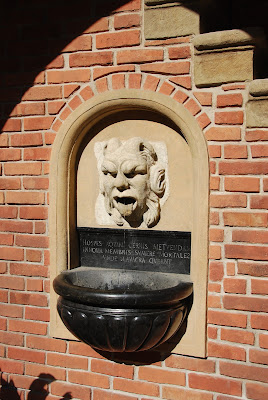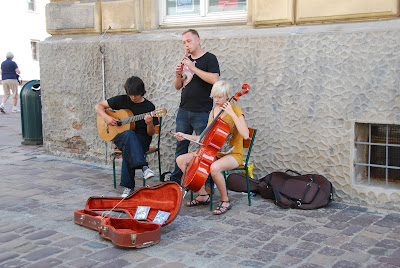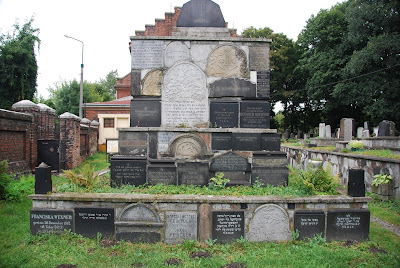On this trip to Poland, the last two days were spent in Krakow. One of the Habitat team members left for other travel on Aug. 26, but the rest of us were able to enjoy the culture and great atmosphere of Krakow for a bit longer. Being a bit familiar with the city from our time there a couple weeks earlier, it was easy to move into the rhythm of the city and all it has to offer.
Despite being occupied by Germany in World War II, Krakow was virtually unscathed in terms of physical destruction. This changed, however, after the war when the Soviet Union took over and left it imprint on the city in the form of heavy industry. Fortunately, most of the architecture and historical sites in the city remained in tact. On the morning of our first full day back in Krakow, we took a guided tour of the "Old Town" - Wawel Hill with the cathedral and castle courtyard, Royal Way, Main Market Square, the university district and more.
In the Main Market Square, one can see St. Mary's Basilica, which is located in a place where a church has stood for over 800 years. The middle of the Square is occupied by the Cloth Hall, where cloth sellers had their market stalls in the middle ages. The Cloth Hall is still a functioning market, mostly for souvenirs, crafts and trinkets. In the 14th century, it was made a permanent structure by King Kazimierez the Great, who is described as a "larger-than-life" medieval king. His his imprint on the city is widespread - buildings, support for the arts, war and diplomacy. He is credited with establishing Krakow as a major capital in Europe (capital was later moved to Warsaw). The second oldest university in Central Europe (Jagiellonian) was established by Kazimierez the Great. He was progressive and tolerant, with one example being his encouragement of Jews moving to Krakow and giving them special privileges in banking and trade.
The next picture seems like it could be almost any place where there are street vendors - it sure is colourful.
From the Square, we then walked a short distance to a courtyard at Jagiellonian University. Two of the interesting things about the courtyard are 1) a fountain on one of the walls that is supposed to bring good luck to students if they touch the water flowing from the mouth; and 2) a twisted chimney (don't remember its significance, but it is intriguing).
From the courtyard, we worked our way along what is called the Royal Way to Wawel Hill (VAH-vehl), which sits on one of the few hills in the city. On the hill, we toured the Cathedral, but spent most of our time exploring outside on a beautiful sunny day. The Cathedral is located on a site occupied by a cathedral for about 1,000 year and it is sometimes described as Poland's version of Westminster Abbey. I haven't been to the latter, so don't really know! It holds the tombs of most of the country's important rulers and historical people. While the interior is interesting, I found the exterior much more impressive. The building's profile has a mix of architect influences as can be seen in the picture immediately below.
After spending some time on Wawel Hill, we walked back to the Square and then were off to pursue individual interests until dinner. Even the shortest walk in Krakow seems to yield something that draws your attention - street performers, historic buildings and more.
We then walked through another part of the Jewish Quarter on our way to Kazimierz Market Square (Plac Nowy) with its eclectic mix of cafes, restaurants, outdoor stands and vendors. Throughout the entire area, the Jewish influence is so strong that one would think the Jewish population today must be much larger. We took a break at the market, so people could wander around a bit and look for the many offerings, but I don't recall any great bargains.
More Krakow
The next day started with a 15-20 minute walk to the Kazimierz area, which is the historic centre of Krakow's once large Jewish community. At the start of World War II, about 65,000 Jews lived in Krakow, but only about 6,000 survived the war. Today, the city has less than 200 Jewish residents.
Our first stop was at one of the Jewish synagogues to walk through the New Cemetery, which certainly leaves one with the impressions of there being a much larger Jewish population in the past. During the war, the Nazis vandalized the cemetery and many headstones were taken away. After the war, however, many headstones have been recovered and re turned to their original sites. For various reasons, others could not be placed in their original site. The latter were used to create a mosaic wall and Holocaust monument.
After a short tour of a synagogue, we headed back to our hotel to take van to our last tourist attraction - the Wieliczka Salt Mine.
While the salt mine is one of the major attractions of Krakow, I must say I was a bit doubtful prior to the tour. It's certainly not one of my favourite sites in the city, but it was well worth the time. The mine has been producing salt since 1250 and during the time of Kazimierz the Great it provided one-third of the country's revenue. Miners spent much of their lives underground and rarely emerged into daylight. To pass their non-work time underground, they were industrious in carving figures, including a chapel of salt.
Our tour started by walking down stairs and through tunnels to 210 feet below ground for our first information session and eventually ended at 443 feet below the surface. The mine has more than 200 chambers and on the tour there are numerous displays showing underground life and work. Probably the most impressive feature is the huge Chapel of the Blessed Kings, which was carved over a 30-year period early in the 20th century. As with so many museums and historic attractions, the tour ends with a deep underground shopping zone. After navigating the shopping area, we headed for the elevators for our ride back to the surface.
So Long Krakow (for now)
So comes an end to our time in Krakow and Poland. There are many other places that I would like to visit for the first time, but I would return to Poland any time. I found the people to be warm and welcoming. Once again, I thoroughly enjoyed the combination of doing important work for Habitat, getting to know and spend time with local people, and experiencing aspects of the culture, history and lifestyle. I can strongly recommend putting Poland in your travel plans and starting in Krakow is a pretty good idea.
Our tour started by walking down stairs and through tunnels to 210 feet below ground for our first information session and eventually ended at 443 feet below the surface. The mine has more than 200 chambers and on the tour there are numerous displays showing underground life and work. Probably the most impressive feature is the huge Chapel of the Blessed Kings, which was carved over a 30-year period early in the 20th century. As with so many museums and historic attractions, the tour ends with a deep underground shopping zone. After navigating the shopping area, we headed for the elevators for our ride back to the surface.
So comes an end to our time in Krakow and Poland. There are many other places that I would like to visit for the first time, but I would return to Poland any time. I found the people to be warm and welcoming. Once again, I thoroughly enjoyed the combination of doing important work for Habitat, getting to know and spend time with local people, and experiencing aspects of the culture, history and lifestyle. I can strongly recommend putting Poland in your travel plans and starting in Krakow is a pretty good idea.
The largest river in Poland - the Vistula - flows through Krakow.











No comments:
Post a Comment